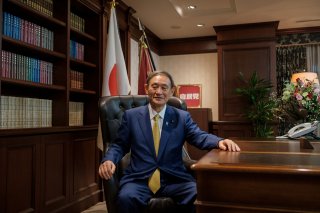Prime Minister Yoshihide Suga Charts Japan’s Next Course
Creating an effective and sustainable counterweight to Chinese power without triggering a cold or hot war will take patience, persistence, and pragmatism.
However, in the South China Sea, Suga worries about China carving out a bastion under Beijing’s exclusive control. Despite more routine freedom of navigation exercises by the U.S. Navy in the South China Sea, China continues to speak and act in a manner demanding that smaller neighbors accept the fact of strategic geography and Beijing’s narrative of China’s inevitable rise.
China’s most recent acts of intimidation included a set of military exercises where its anti-access and area-denial (A2/AD) capabilities were ostentatiously on display. In August, China launched both the DF-21D “carrier-killer” ballistic missile and DF-26B intermediate-range ballistic missile into an area off the southern island province of Hainan and near the disputed Paracel Islands. The missiles were launched from two different locations: the DF-21D from Zhejiang province near Shanghai and the DF-26B from the northwestern province of Qinghai. The allies rightly see these missiles as providing Beijing with asymmetric advantages. The DF-26B is nuclear-capable, which underscores why Tokyo and Washington are interested in filling significant gaps in their offensive capabilities.
Recently, both the United States and Japan have taken steps to counter China’s substantial missile capability. In 2019, the United States officially withdrew from the Intermediate-Range Nuclear Forces Treaty signed by Ronald Reagan and Mikhail Gorbachev. The U.S. withdrawal was a response to Russia’s violations of the treaty, but it also cleared the way for the deployment of new ground-based missiles in the Indo-Pacific region, which could help offset China’s quantitative missile advantage.
Similarly, before Abe stepped down from his leadership position atop the Liberal Democratic Party (LDP), Defense Minister Taro Kono announced the cancellation of one of Japan’s major weapons purchase: the Aegis Ashore ballistic-missile defense system. Aegis Ashore was supposed to be a significant part of the alliance's layered ballistic missile defense network. But at Abe’s final meeting with his national security council on September 11, he hinted at a different defense approach. Abe argued that “there is a question of whether it is possible to protect and defend the lives and the peaceful livelihoods of the Japanese people only by enhancing our interception capability,” referring to Aegis Ashore in particular and missile defense in general. “Under such thinking in order to strengthen the deterrence, the government of Japan has been considering a new course,” Abe added, intimating a desire to acquire offensive missiles. After some twenty-five years of focusing on missile defenses, Japan is now more actively looking at shifting investments into offensive missiles as a means of bolstering deterrence in the face of more heavily armed neighbors, not least because offensive missiles tend to be cheaper than missile defenses. However, convincing the ruling LDP’s coalition political partners in the pacifist Komei Party remains a delicate task.
Keeping U.S. military forces present and ready to deter aggression is also a high priority for any Japanese prime minister. For Suga, there is the challenge of retaining a healthy U.S. force presence while averting the kind of public shakedown Trump used in South Korea. Trump looked to Seoul to pay a 500 percent increase in host-nation support to ensure U.S. military forces there could remain forward based in South Korea.
As former national security advisor John Bolton noted in his memoir, The Room Where It Happened, the Trump administration demanded a “cost plus 50 percent” formula from allies hosting U.S. troops. Bolton writes that he “feared Trump’s ultimate threat—withdrawing our troops from any country not paying what he deemed to be an adequate amount—was real in South Korea’s case.” The transactional, unilateral, isolationist move would have achieved in one fell swoop what China was eager to accomplish through arduous and multiple means.
Suga is apt to defer this debate, perhaps through a short-term bridging agreement. But he is also likely to keep the U.S. satisfied and preserve U.S. presence by pushing to conclude the procurement of Mageshima Island. The uninhabited island off the coast of Kyushu Island, and last used by Imperial Japan in defense of Okinawa during World War II, is a vital piece of real estate. The island will provide safer and less congested training for both U.S. and Japanese pilots, as they continue to maintain vigilance in the adjacent air space and seas.
Together, the United States and Japan, along with countries like Australia and India, can help Indo-Pacific region nations retain strategic autonomy as China’s power and ambitions continue to expand. However, providing an effective and sustainable counterweight to Chinese power without triggering a cold or hot war will take patience, persistence, and pragmatism.
Pompeo’s shortened trip to Asia still promises to pack in serious diplomacy. But if, as expected, there is a change in U.S. administrations, the secretary of state may soon find himself writing a memoir of his past four years. That volume might, in turn, double as a job application for the Republican presidential nomination in 2024.
Dr. Patrick M. Cronin is the Asia-Pacific Security Chair at the Hudson Institute.

